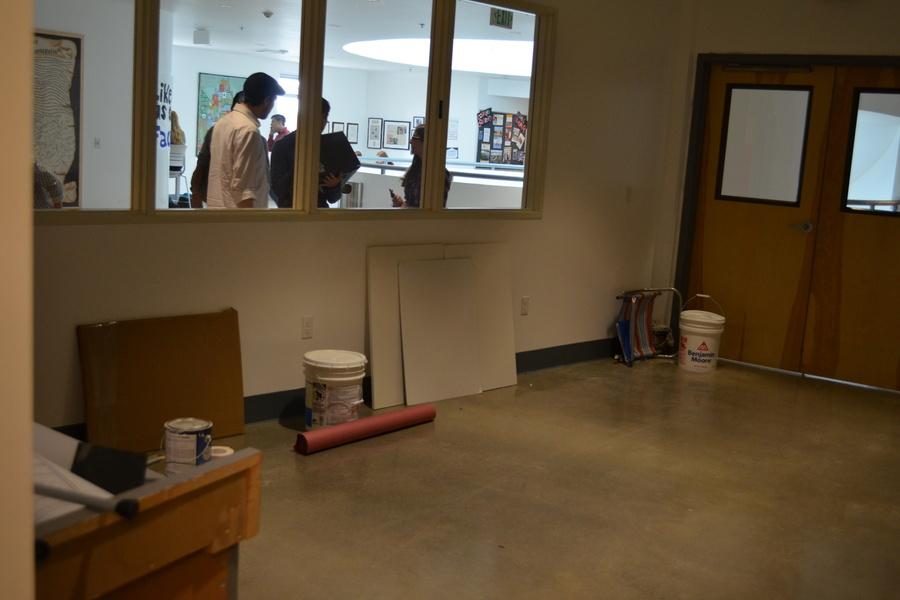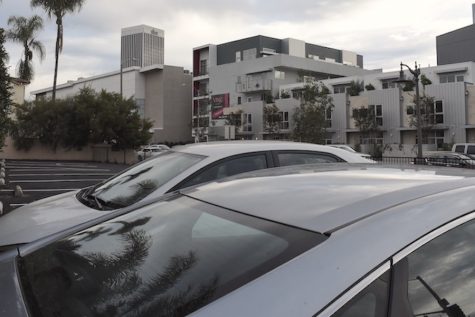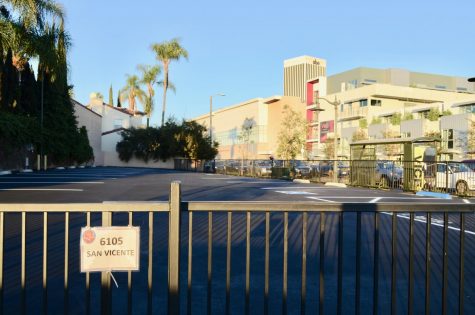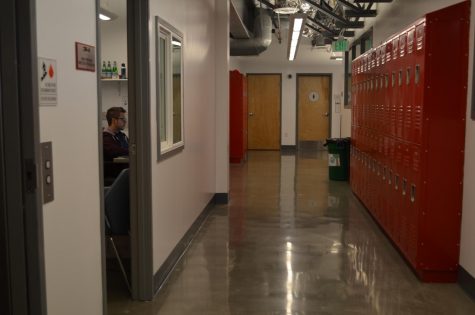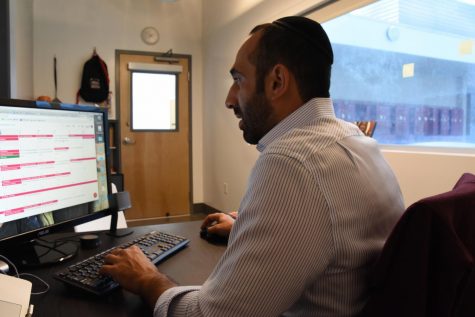More classrooms built for record student body, staff
BUILT: New STEM room for the Robotics team replaced Genius Bar on second floor, is almost complete.
New construction throughout Shalhevet’s building has brought new space for seven new teachers, a record high student body at 245, and a few new problems too, ranging from temperature in the basement classrooms to students getting to and from the basement to the third floor for class.
With four new classrooms, a dividing wall in the Beit Midrash, and a STEM lab on the second floor, students and teachers now have 23 classrooms to use counting the STEM lab, up from 16 last year and 17 in the old building. Also employed for classes this year is the stage of the Wildfire Theater, where Principal Reb Noam Weissman teaches a Jewish Philosophy section to over 35 students and Ms. Tamara Gidanian teaches Honors Algebra 2 to 22.
Executive Director Robyn Lewis and General Studies Principal Mr. Daniel Weslow said Shalhevet’s expanding population is the main driver behind the construction. The incoming freshman class this year has 67 students, the largest at least since 2002.
Ms. Lewis said the Tuesday afternoon presence of Ikar synagogue’s religious school also strained classroom space. The new classrooms will allay this pressure on Tuesdays and throughout the week, she said.
“On Tuesdays, when IKAR is in the building, it was very tight for students and teachers to be able to have their classes and continue their classes,” she said. “So we thought if we could create additional spaces downstairs on Tuesdays, it just alleviates the pressure.”
Most of the new classrooms are the same size as the rooms on Shalhevet’s second floor, except for a room in the center of the basement which can accommodate much larger classes if need be.
The basement classrooms have air vents, but are not connected to the central air conditioning system that cools the rest of the school. Four wall air conditioning units installed in August have helped, though they have caused teachers to have to choose between cool temperatures and distracting noise.
“It’s a judgment call, because you don’t want it to be too hot in the classroom, but when do you have to turn it off because you can’t actually hear what people are saying and they can’t hear each other?” said Jewish History teacher Mr. Jeremy Shine.
Also, the only way for students to get to the basement is via the pre-existing staircase that slips downward between the kitchen and patio. There is a second staircase in the basement for mostly emergency use, leading outside of Shalhevet out onto Fairfax Avenue. Maintenance staff have access to it during the day, and students can use it in case of emergency purposes, according to Mrs. Lewis.
Getting from classes on the third floor to the basement and visa versa has been difficult for students during the school’s five-minute passing periods, but teachers have been understanding.
Sophomore Ami Nelson has Jewish History on the third floor and then Hebrew in the basement. He said he’s often late to Hebrew.
“It’s pretty hard to get all your stuff from your locker and get to the basement in the span of five minutes,” said Ami.
His teacher, Ms. Shlomit Abrams, who uses room B104, said her last-period classes frequently start a few minutes late, though she still holds students responsible for being on time.
Ms. Lewis recommended students in that situation use the staircase that runs along the exterior of the building by the parking lot, instead of the spiral staircase in the central foyer which is used the most. Also, bringing things for both classes to the first class would mean you don’t have to stop at your locker in between.
New ninth- and tenth-grade English teacher Mr. Eric Smith likes being in the basement, despite its issues, and the fact that it has been dubbed “the dungeon” for its colors and location. Teachers who use the upstairs rooms generally teach different periods in different rooms.
“I like it, if I can be in one classroom all the time,” said Mr. Smith. “And it’s kind of off the beaten path, because I’m kind of off the beaten path. Then I kind of like my anonymity amongst the group. ”
Mr. Smith shares his room with Dr. Keith Harris and Mr. Shine, but still feels as though it is his own space and said he has enjoyed bonding with the other new teachers there.
Freshman Caroline Edry likes the basement for similar reasons.
“I like that we have classes in the basement because we kind of get out of the building — even though it’s the same building, I just like being in a different area,” Caroline said.
On the second floor, the Robotics team’s new STEM (Science, Technology, Engineering, Math) room is almost finished, located where the Genius Bar and one of the Wildfire Theater’s two catwalks used to be. The Genius Bar has been moved to open space at the south side of the second floor, near rooms 216 and 218.
According to Drama teacher Ms. Emily Chase, the second catwalk was not functional, and the remaining also has a storage unit built by alumnus Mati Davis 16’ as part of a Boy Scouts project.
“The catwalks are only useful for long-term storage, so it wasn’t a big deal,” Ms. Chase said in an e-mail. “We still have the other one.”
In the Beit Midrash, a white, detachable folding wall now splits the Beit Midrash in half for two classes to occur there at the same time. The separator has the same sound rating as regular drywall, Ms. Lewis said.
“Everyone is keeping in mind JCC,” MS. Lewis said, referring to a dividing wall with a poor sound rating in the Westside Jewish Community Center. “It’s not the JCC – we’re choosing the highest grade closing doors that exist.”
The split room has been occupied primarily by larger Judaics classes, such as Rabbi Schwarzberg’s Tanach and Talmud sections, Mr. Feld’s Modern Middle East course, Rabbi Gormin’s Talmud and Jewish Philosophy sections, Mr. Weslow’s English class, and Reb Weissman’s Halacha Shiur.
On the right side of the room, a wall-sized new bookcase built over the summer by Shalhevet’s maintenance staffers stores Tefillin, siddurim, and Judaica.
The bookcase was designed Ms. Lewis and Judaic Studies teachers Rabbi Ari Schwarzberg and Rabbi David Stein and built by maintenance staff Jose Flores, Diego Agustin Sanchez and Javier Dominguez.
“We wanted something that would really create a Beit Midrash that both in function and appearance communicates centrality of learning,” Rabbi Stein said.
The trio plan to populate bookshelf over the next six months by purchasing more books or through donations.

Hannah Jannol was Editor-in-Chief of the Boiling Point during the 2017-2018 school year. Since then, she has attended The New School and written for their HerCampus chapter; edited obituaries for The Trace; written poetry for Eleven and a Half literary magazine, and run Instagram and Twitter for Uptown Stories. Her favorite parts of being on Boiling Point were production night and writing long-form features stories, many of which won awards from CSPA, Quill & Scroll and the American Jewish Press Association.

